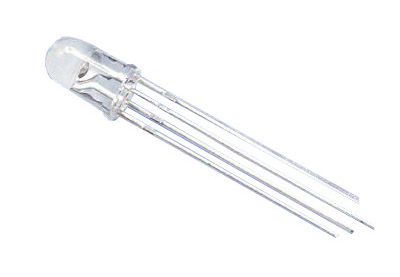
But, such cases are rare, and there’s only a tiny chance this method won’t show the correct polarity. Sometimes, the larger plate may connect to the anode. Although it’s a simple method, you’ll need to look closely or use a magnifier. The smaller one connects to the anode, while the larger one links to the cathode. One of these plates is bigger than the other, which also helps to indicate polarity. If you look inside, you may see two metals, depending on your LED type. One more visual method to try is the size of the metal plates inside the LED. Plus, you won’t need any tools to check, only your eyes. Unlike the terminal length, this method always helps determine polarity. The terminal next to the flat side is the anode, while the cathode is under the rounded side. Here’s another easy visual method you can try if the first one doesn’t work.
So, a closer look will show that one side is round and the other flat, which helps you determine the polarity. Hence, this method is ineffective if you’ve used the LEDs or some parts of the terminal are cut. However, this method only works for brand-new LEDs. So, the longer term is the anode, while the shorter one is the cathode. Its purpose is to help you decide which one is negative or positive. New LEDs always have one terminal longer than the other, and it’s not a manufacturing error. One easy way to determine LED polarity is the terminal length. Let’s look at these methods and how they work. There are multiple ways to detect an LED’s polarity. In LEDs, current can only flow from the anode to the cathode, which explains why connecting them in the right direction is crucial.įurther, every LED has some indication to determine the cathode or anode terminal. So, the cathode is the negative terminal, while the anode is the positive one. Like their diode cousins, LEDs have two terminals (anode and cathode). And when it comes to polarity, LEDs are very similar.

This requires only two pins from the Arduino (data & clock), and they can be chained to have multiple 7-segments driven from those same 2 pins.Diodes are unilateral devices that allow current flow in only one direction. This limits you to being able to display only numerical digits, but uses only 4 pins of the Arduino per 7-segment.Īnother, more versatile way is to add a serial-in to parallel out chip (74HC595, for example) to drive the 7-segment. One is to add a 7-segment driver, like the CD4511. There are a couple of ways to address this. You will run out of digital pins if you try to add a second 7-segment. The way that you are diving the 7-segment involves using a separate pin to drive each segment, so you use 8 pins of the Arduino to drive the display. So driving one of these means running a current from the particular anode (positive) pin for the desired segment to the common cathode pin.

So turning on any particular segment will involve running a current from this common anode (positive) pin to the particular cathode (negative) pin for the desired segment.Ĭommon cathode means that the cathodes of all of the LEDs are common and connected to a single pin. Common anode means that the anode (positive) side of all of the LEDs are electrically connected at one pin, and each LED cathode has its own pin. PinMode(LED8, OUTPUT) // led 8 is outputĪ 7-segment is a packaged set of 8 LEDs (7 number-segments & 1 decimal point). PinMode(LED1, OUTPUT) // led are output for low will be on PinMode(ANODE, OUTPUT) // common anode is obviously an output

ACTIVE LOW CATHODE LED CODE
How can you change the code to have a counter in backwards (from 0 to 9)? const int ANODE = 2 What is the difference in using a common anode and common cathode of the 7 Segment in interfacing with the Arduino? How can you change the code if we need to add another 7 Segment display?


 0 kommentar(er)
0 kommentar(er)
